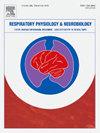高强度耐力运动员的呼气流量限制:在跑步机上跑步时FEF25-75%和通气量的作用。
IF 1.6
4区 医学
Q3 PHYSIOLOGY
引用次数: 0
摘要
背景:高度训练的个体在运动期间的呼气流量限制(EFL)被认为是由于通气需求增加超过呼吸系统的能力,而呼吸系统不能完全适应运动训练。用力呼气流量减少至用力肺活量的25-75% (FEF25-75%),这是小气道功能的标志,可能通过限制运动呼吸急促时可用的最大呼气流量而有助于EFL。本研究调查了训练有素的耐力运动员在有EFL和没有EFL的情况下,FEF25-75%、峰值分钟通气量(V (E))和呼吸模式是否存在差异。方法:40名高强度耐力运动员(男20名,女20名;V * O2max: 59.6±9.2mL∙kg-1∙min-1)完成肺活量测定和最大增量心肺跑步机运动试验。根据呼气末肺容量,通过在最大流量-容量环路内叠加潮汐流量-容量环路来评估EFL。结果:在最大强度运动中,40%的参与者(n = 16:男性7人,女性9人)发展为EFL,性别差异无统计学意义(P < 0.05)。EFL组运动员FEF25-75%(3.45±0.78比4.16±0.98L∙s-1, P=0.020, d = 0.802)显著低于对照组(3.45±0.78比4.16±0.98L∙s-1, P=0.020, d = 0.802),通气需气量比(V (E) /V (Ecap))(0.86±0.14比0.66±0.11,PE)显著高于对照组(P < 0.05)。结论:在一组训练有素的耐力运动员中,最大限度的跑步机运动期间的EFL似乎主要是由产生呼气流量的能力降低引起的,FEF25-75%的降低证明了这一点,而不是通气需求的差异。本文章由计算机程序翻译,如有差异,请以英文原文为准。
Expiratory flow limitation in highly trained endurance athletes: The role of FEF25–75% and ventilatory capacity during treadmill running
Background
Expiratory flow limitation (EFL) during exercise in highly trained individuals is thought to result from increased ventilatory demands that exceed the capacity of the respiratory system, which does not fully adapt to exercise training. Reduced forced expiratory flow between 25 % and 75 % of forced vital capacity (FEF25–75 %), a marker of small airway function, may contribute to EFL by limiting the maximum expiratory flows available during the hyperpnea of exercise. This study investigated whether FEF25–75 %, peak minute ventilation (V̇E), and breathing patterns differ between highly trained endurance athletes with and without EFL.
Methods
Forty highly trained endurance athletes (20 males and 20 females; V̇O2max: 59.6 ± 9.2 mL∙kg−1∙min−1) completed spirometry and a maximal incremental cardiopulmonary treadmill exercise test. EFL was assessed by superimposing tidal flow-volume loops within the maximum flow-volume loop according to end-expiratory lung volume.
Results
During maximal exercise, 40 % of participants (n = 16: 7 males, 9 females) developed EFL, with no significant sex differences (P > 0.05). Athletes with EFL had significantly lower FEF25–75 % (3.45 ± 0.78 vs. 4.16 ± 0.98 L·s−1, P = 0.020, d = 0.802) and a higher ventilatory demand-to-capacity ratio (V̇E/V̇Ecap) (0.86 ± 0.14 vs. 0.66 ± 0.11, P = 0.002, d = 1.589) compared to those without EFL. There were no significant differences in absolute tidal volume, breathing frequency or V̇E between groups (P > 0.05).
Conclusion
In a homogeneous cohort of highly trained endurance athletes, EFL during maximal treadmill exercise appears to be primarily driven by a reduced capacity to generate expiratory flow, as evidenced by lower FEF25–75 %, rather than differences in ventilatory demand.
求助全文
通过发布文献求助,成功后即可免费获取论文全文。
去求助
来源期刊
CiteScore
4.80
自引率
8.70%
发文量
104
审稿时长
54 days
期刊介绍:
Respiratory Physiology & Neurobiology (RESPNB) publishes original articles and invited reviews concerning physiology and pathophysiology of respiration in its broadest sense.
Although a special focus is on topics in neurobiology, high quality papers in respiratory molecular and cellular biology are also welcome, as are high-quality papers in traditional areas, such as:
-Mechanics of breathing-
Gas exchange and acid-base balance-
Respiration at rest and exercise-
Respiration in unusual conditions, like high or low pressure or changes of temperature, low ambient oxygen-
Embryonic and adult respiration-
Comparative respiratory physiology.
Papers on clinical aspects, original methods, as well as theoretical papers are also considered as long as they foster the understanding of respiratory physiology and pathophysiology.

 求助内容:
求助内容: 应助结果提醒方式:
应助结果提醒方式:


